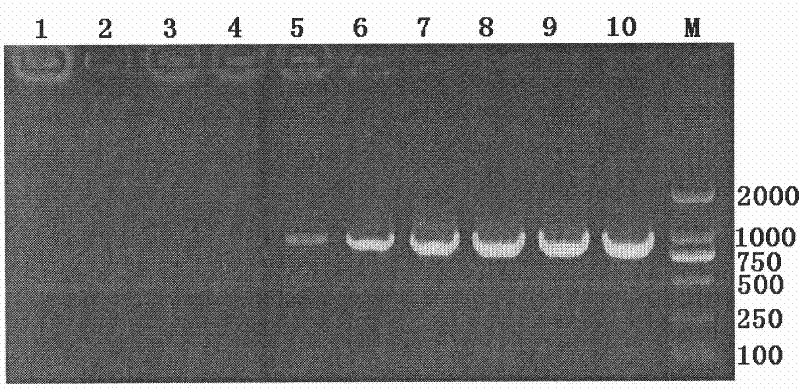Polymerase chain reaction (PCR) detection method for distinguishing virulent strains and vaccine strains of duck plague virus (DPV)
A technology of duck plague virus and detection method, which is applied in the field of scientific research and production of animal medicine, can solve problems such as inability to judge duck farms, and achieves the effect of simple judgment method and broad application prospect.
- Summary
- Abstract
- Description
- Claims
- Application Information
AI Technical Summary
Problems solved by technology
Method used
Image
Examples
Embodiment 1
[0027] Embodiment 1 Differentiate the PCR detection method of duck plague virus virulence and vaccine attenuation
[0028] 1 test material
[0029] The 10-day-old duck embryo was negative for DPV and antibody of the breeding duck.
[0030] 2× Dumb PCR Mixtrue, purchased from Bao Biology.
[0031] Virulent duck plague virus: Duck plague virus CH virulent strain (DPV CHv), referred to as CHv strain, was isolated and preserved in this laboratory. Center (CCTCC), deposit number: CCTCC NO: V201209, classified as duck plague virus CH virulent strain (DPV CHv).
[0032] Duck plague virus attenuated vaccine virus: purchased from Chengdu Tianbang Biological Products Co., Ltd., veterinary drug production license number: (2006) veterinary drug production certificate number 07022; approval number: veterinary doctor word (2006) 070222023.
[0033] 2 Experimental methods
[0034] 2.1 Preparation method of normal duck embryo fibroblasts (DEF)
[0035] Take 10-day-old healthy duck embryo...
Embodiment 2
[0052] Embodiment 2 PCR specificity evaluation test
[0053] Duck viral hepatitis virus (DHV) ATCC VR1313, infectious laryngotracheitis virus (ILTV) ATCC VR-783, Marek's virus (MDV) ATCC VR-585, Muscovy duck parvovirus (MDPV) CVCC AV238, Avian Influenza (AIV) CCTCC-V200312, Riemerella Anatipestifer (RA) ATCC 11845, Salmonella Duck (Sa1.A) CMCC 50083, Pasteurella (PM) CAU0085 and Duck Escherichia coli (E.coli) CVCC 83003 by The DNA extracted by the conventional method was subjected to PCR, and at the same time, a positive control of the attenuated vaccine strain, a positive control of the strong virulence of the CHv strain, and a blank control were set up, and the reaction system and parameters were the same. Similarly, 6 μL of the PCR product was electrophoresed on a 1% agarose gel, and DL2000 was set, and the presence or absence of amplified fragments was observed by ultraviolet light irradiation.
[0054] For the test results of the specificity test, see figure 2 , in the...
Embodiment 3
[0055] Sensitivity test of embodiment three PCR detection
[0056] Method 1: TCID 50 sensitivity
[0057] Use 1.5*10 8 TCID 50 / ml of CHv strain duck plague virulent virus to extract DNA, also use 2*10 5.5 TCID 50 / ml of duck plague attenuated vaccine strain virus extraction DNA, the templates were diluted to 10 times the concentration gradient by 10 times. 8 Carry out PCR amplification, and set up a blank control at the same time. The reaction system and parameters are the same. Take 6 μL of PCR products and electrophoresis on 1% agarose gel.
[0058] TCID 50 For the results of the sensitivity test, see image 3 ;In the figure: Lane 10 is undiluted DNA, 1.5*10 8 TCID 50 / ml; Lane 9: 1.5*10 7 TCID 50 / ml; Lane 8: 1.5*10 6 TCID 50 / ml; Lane 7: 1.5*10 5 TCID 50 / ml; Lane 6: 1.5*10 4 TCID 50 / ml; Lane 5: 1.5*10 3 TCID 50 / ml; Lane 4: 1.5*10 2 TCID 50 / ml; Lane 3: 1.5*10TCID 50 / ml; Lane 2: 1.5TCID 50 / ml; lane 1: blank control; lane M: DL2000. It can be se...
PUM
 Login to View More
Login to View More Abstract
Description
Claims
Application Information
 Login to View More
Login to View More - R&D
- Intellectual Property
- Life Sciences
- Materials
- Tech Scout
- Unparalleled Data Quality
- Higher Quality Content
- 60% Fewer Hallucinations
Browse by: Latest US Patents, China's latest patents, Technical Efficacy Thesaurus, Application Domain, Technology Topic, Popular Technical Reports.
© 2025 PatSnap. All rights reserved.Legal|Privacy policy|Modern Slavery Act Transparency Statement|Sitemap|About US| Contact US: help@patsnap.com



